Peak: Cerro Aconcagua (22,841‘), Argentina
Dates: December 29, 2008 – January 8, 2009
Partner: Ryan Scollard
Route: Normal Route from the Horcones Valley
Stats: ~50 Miles, 18,000 Feet
Total Time On Mountain: 11 Days
Well here we go . . . I‘m not even really sure where to start with this one. When we returned from South America two Sundays ago and I was driving home from DIA with my wife in the passenger seat, I remember thinking, “this will likely be the wildest story with my name it that I will ever tell.” From a myriad of logistical problems getting to the mountain, to losing my only partner two days into our climb, to joining a Brazilian expedition and then a rescue operation at 20,000‘, to being mugged in the streets of Mendoza and spending five days in a third-world hospital, to sitting and having coffee with a two time K2 summiter and veteran Himalayan guide, this one certainly had enough to write a short book about.
Ryan and I had our sights on Aconcagua in July and managed to turn our dream into a reality about a week later when we booked the tickets and began the long preparation process. From the beginning we elected to go without a guide as we were confident in our abilities to handle our own expedition, and guides are expensive. For months we planned, scheduled, trained, researched, read books, articles, and trip reports, to the point that, when we left on Christmas Day, I believed we had done what it would take for a flawless trip to Aconcagua. Unfortunately I ended up being wrong.
Ryan and I flew from Denver to Santiago, Chile in a little under twenty-four hours. Our plan was to take a bus over the Andes to Mendoza, buy our permits and stock up on food and fuel, then head for the mountain. We arrived in Santiago to find that our baggage had been lost (LAN Chile is a terrible airline) with no way of knowing when we could expect its arrival. We traveled into the city and found a cheap hostel where we would stay the night and head back to the airport the following morning. Much to our relief our bags showed at 9am and a few hours and headaches later, we were on our way over the Andes on a private short bus.
The drive was relatively uneventful, the views of the Andes were unbelievable, and being only twenty-four hours behind schedule, our trip was going more or less as planned. We arrived in Mendoza on the evening of the 27th and quickly found a hostel. From here we would head out the next day to buy permits, food, and fuel, a relatively tall order for one day but we ended up getting it all done. Another night in the hostel and we were on the 6am bus to Penetentes.
When we arrived, Osvaldo from our mule operator Lanko was waiting by the bus stop. He quickly took us to his shop where we sorted our bags for mule transport to Plaza de Mulas. An hour later we were on the trail up the Horcones Valley, Aconcagua looming two vertical miles above us. We were excited at this point, finally making it to the mountain after five days of hellacious logistics was refreshing, we were finally doing what we came to do.

Hiking along the well worn trail to Confluencia, Dec 30.
The hike to Confluencia took us roughly three hours, the trail winds up through the massive glacial valley at the foot of Aconcagua to a split between two valleys (one leads to the South Face base camp Plaza Francia, the other to the primary base camp at the foot of the normal route). We arrived in the early afternoon and began striking camp next to the Lanko site.
Confluencia was much more commercialized than I expected; the camp consisted of over a hundred tents including giant mess tents, portable restrooms and shower facilities, medical tents, dormitory tents, there was even a volleyball court. I was instantly enthralled with being at my first “real” camp, this was like the stuff I‘d read about in so many mountaineering books. Ryan and I strolled across to the medical tent to get our vitals checked. The doctor did not like the fact that we had come from Mendoza that same day, but cleared us both to climb to Plaza de Mulas the following morning.
We ate dinner under the sunset painting the 17,000‘ Tolosa bright orange, an hour later we were in our sleeping bags, excited as ever for what was to come. We were here. We were doing it. This was the last time before arriving in Denver I would feel quite so relaxed.
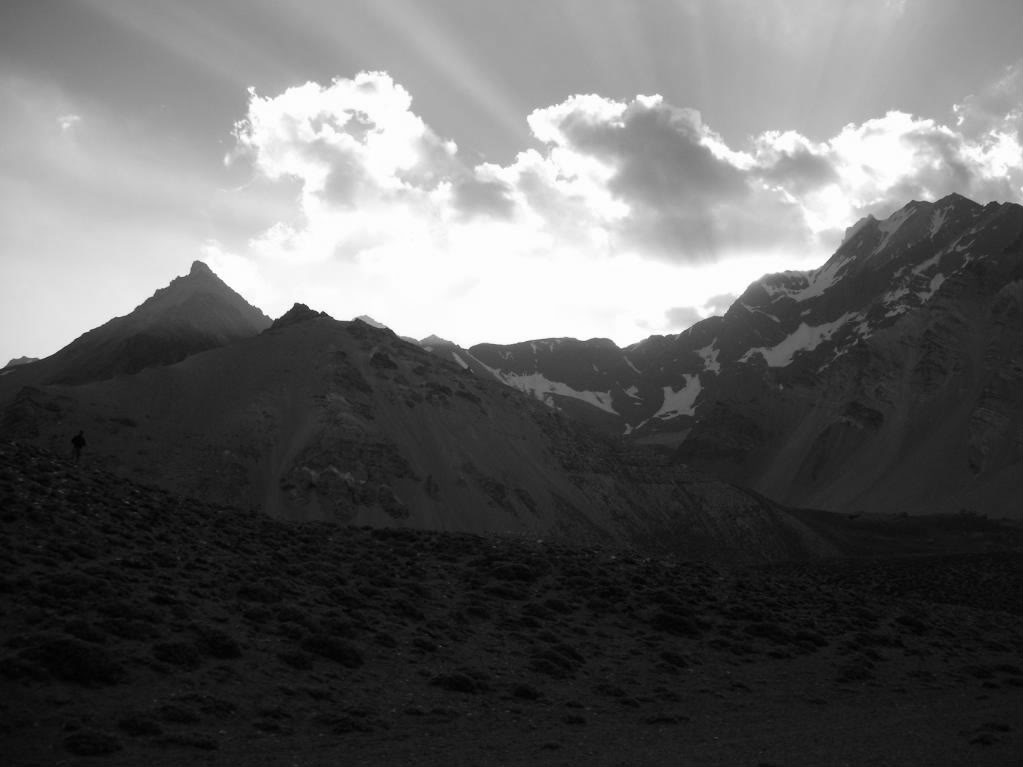
“Tolosa” from Confluencia, Dec 29.

Camp Confluencia in the evening, I believe the mountain is “Dedos”, Dec 29.
Ryan and I awoke to helicopter blades cutting through the thin mountain air, apparently someone needed to be flown out to the park entrance from Confluencia, presumably due to AMS. We were surprised that a heli evac was necessary at the moderate altitude of 11,000‘, but I guess the books say it can happen at even the tamest elevations…
We headed over to the Lanko breakfast tent and scarfed down on biscuits and coffee, broke our camp down, filled up with several liters of water and headed off. We wanted to get to Mulas early in the trip, this desire was compounded by the fact that we had lost a day waiting on our luggage in Chile, and we didn‘t have a great deal of extra days. We reasoned that because we had been to the same elevation as Mulas (14,000‘) so many times, we could get there quickly and rest for a few days if necessary. Foregoing the extra day at Confluencia would turn out to be a mistake.

Camp Confluencia from above, Dec 29. This was the first real “camp” that either of us had been to.
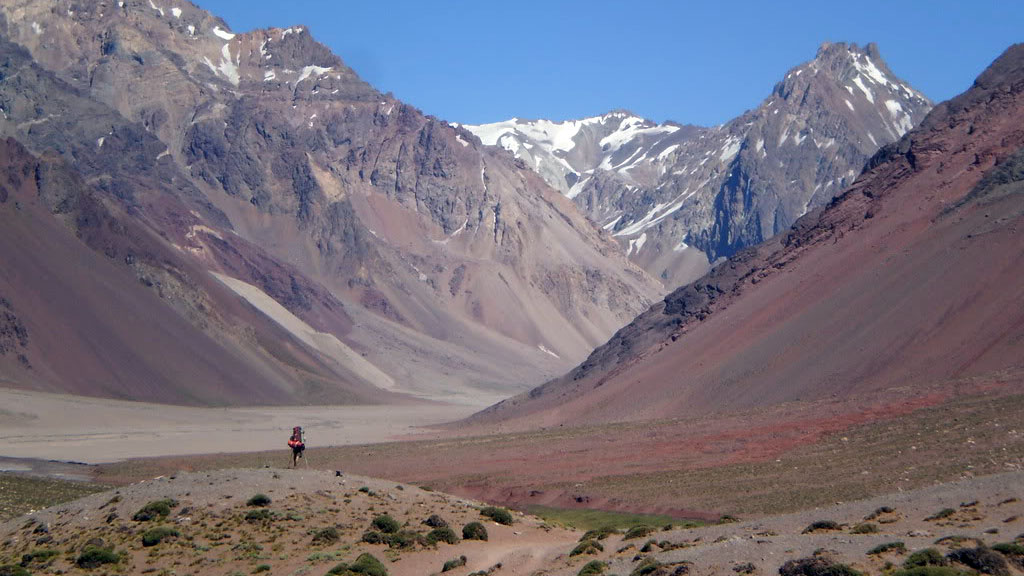
Ryan with the massive Horcones Valley in front of him, Dec 30.
The route from Confluencia to Mulas involves ten miles of hiking through arid, rugged valley. This is thought by many to be the most difficult day of the climb next to summit day due to the fact that most parties have a lot of weight, and water is scarce. The first five miles or so were a breeze, there is a giant canyon just past Confluencia which must be crossed but afterwards the route heads through the flat valley for hours. Gigantic mountains at the head of the valley would appear to get no closer after hours of hiking, and mules constantly trotted up and down from the park entrance to Mulas ferrying gear from all sorts of different expeditions.
After several hours of trekking, Ryan and I noticed the terrain began to increase in grade, and Ryan told me he was beginning to feel weak from the heat. We continued on for another hour or so and came to what is known as “Columbia”, an old broken down refuge about an hour below Mulas.

Aconcagua‘s south summit is behind the clouds to the right of Pyramidal, Dec 30.
I remember seeing Cerro Cuerno at the end of the valley, so I knew we were getting close. I told Ryan we had only one big final push of elevation before Mulas, and I was anxious to get there as the sun was beginning to wane. It was around this time that I noticed Ryan‘s cough. At first I thought this was strange because I had not noticed him cough at all for the entire trip. I remember thinking maybe he just had something in his throat, and that there was no way it could be what was creeping into my mind. He coughed again, this time it had a distinct liquid sound attached to it, like during the final clearing stage of a cold. “Where did that come from?” I asked. “I‘m not sure”, Ryan said, “it just started.” Another cough, again distinctly liquid in nature. “Damn”, I said, “how do you feel otherwise?” “Very weak.”
Although I did not want to say it aloud, I was fairly certain at this point that our worst fears had been realized; he had pulmonary edema. My mind then immediately began racing, “well we‘re below the largest vertical gain of the day, and to drop any significant elevation we would first need to hike horizontally for miles, we‘re in the middle of the Andes and its getting dark, but there is medical attention at Mulas.” It was clear that backtracking to Confluencia would take several hours, and Ryan was reporting feeling very weak, so that didn‘t seem like a good option. It was also clear that ascending a thousand feet would be the worst thing we could do for his condition, and it would take him at least three hours at his current energy level. I remember thinking “this is literally the worst place you could get sick dude.”

Aconcagua‘s massive west face from just below Mulas, Dec 30. The summit is nearly 9,000 feet above.
I spotted another party not far from us and ran over to them, I wanted to see if they had a radio. I thought if we could get someone to bring some drugs down to us, we may have a chance of making it to Mulas. It turned out the other party did have a radio, they promptly called Mulas and within thirty minutes there were two “guadalparques” coming down the hill. By the time they reached us Ryan was feeling a bit better, they checked his vitals and instructed us to continue to Mulas. Also joining our group were two Italians who were struggling with the altitude. Ryan and I, the two rangers, and the Italians were together until we reached Mulas. Ryan‘s condition was far from comfortable, he was coughing and struggling with his pack so I decided to shoulder some of his weight. It was difficult to see my friend who is normally so strong in the mountains having such a rough time.
We reached Mulas around 9pm, it had taken three hours to ascend a thousand vertical feet, and Ryan‘s cough started to worsen again. After a short checkup in the medical tent we were instructed to strike camp and drink three liters of hot tea, then return to the medical tent if the situation did not improve. About two hours later Ryan and I were sitting in our tent, downing cup after cup of hot tea when we decided to make the move back to the medical tent. This was at first a difficult decision, Ryan knew what it would mean if we had to return to the doctors, his trip would likely be over. At this point it didn‘t matter, his lungs had a lot of fluid in them and he needed medical attention.
Ryan and I slowly covered the hundred yards to the tent and felt bad about waking up the “medicos”, they instantly had Ryan on oxygen and diamox as soon as they saw him. They also hooked him into an iv for hydration and began giving him antibiotics. We sat in the medical tent for seven hours, Ryan was not allowed to go to sleep, and a helicopter evacuation was ordered for first light. Ryan and I got to know the three doctors fairly well, Fleur, Diana, and Carina were their names. By the end of the night we were singing and exchanging jokes and stories, they were very good to us that night, Ryan and I will never forget it. By the time 8am rolled around Ryan was doing much better.
We discussed what was going to happen; I gave Ryan all the money minus what I needed for phone calls, his passport, some clean clothes, and his sleeping bag. I would stay at Mulas (I desperately needed to sleep) and attempt to contact Ryan the following day to check on his condition. If he was doing well, I would likely try to continue the climb. Just about when we had it all worked out we heard the familiar chopping of the copter we had scoffed at the previous day, Ryan was escorted out of the medical tent, across the helipad and into the copter and in an instant, he was gone. It was difficult to see my only friend in the southern hemisphere whisked away to some unknown place in the condition he was in, leaving me alone in the middle of the Andes.
For the next day I tried to justify continuing, weighing the pros and cons of staying versus leaving. After a bit of wandering around base camp, I met a guy named Bruno who belonged to a Brazilian team. I told him the whole story and he quickly invited me to eat lunch with he and his teammates. After telling them of my mountain climbing experiences in Colorado, I was promptly invited to join their team. As they worked out the logistics of turning a four main team into a five man team, I couldn‘t help but admire their generosity. I hiked to the hotel for the third time in two days and talked with Reuben (a guadalparque) who gave me the phone number to the hospital where Ryan was being treated. I was going to be able to speak to him!
An hour later I was talking to Ryan on the phone, he was being treated in Uspallata, a small town twenty-five miles from the TH on the Mendoza side. After a long exchange, Ryan essentially told me to “go get the son of a b****”. He was going to head to Mendoza to drink wine and enjoy himself.
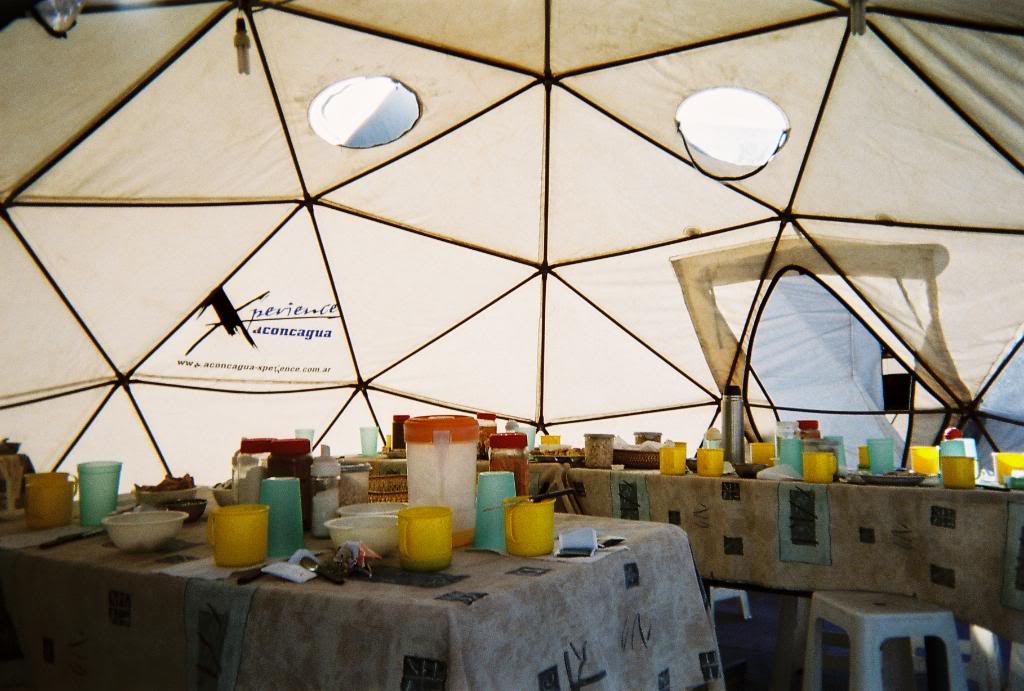
Mess tent interior, Dec 31.
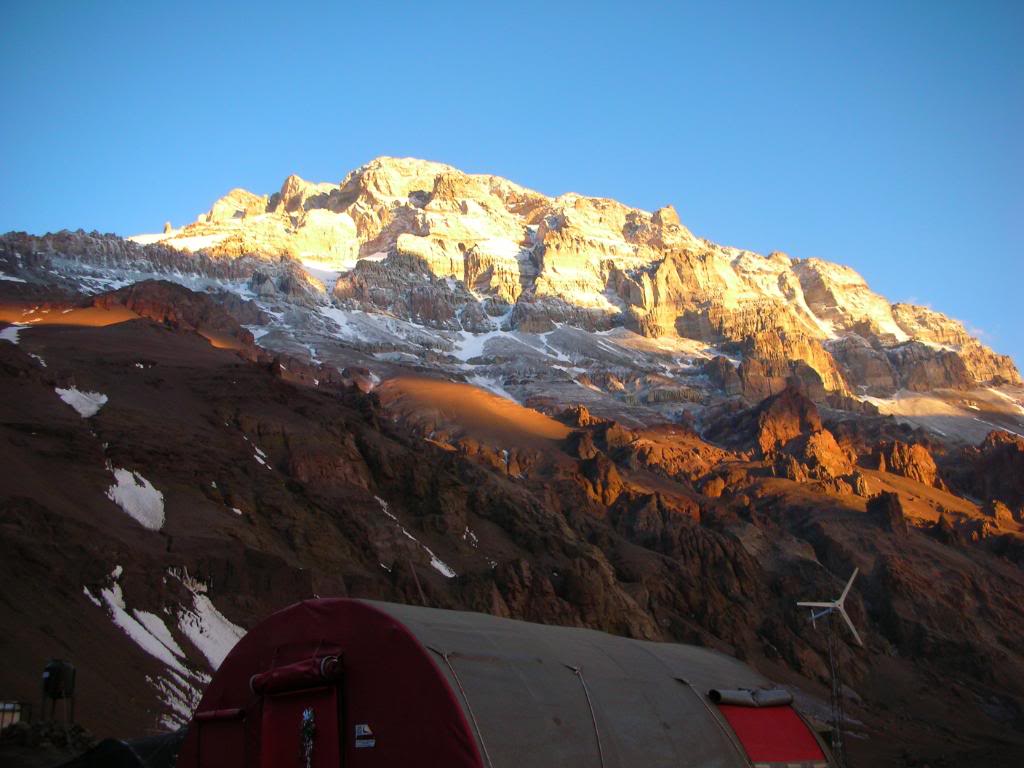
The west face from Plaza de Mulas, Dec 31.
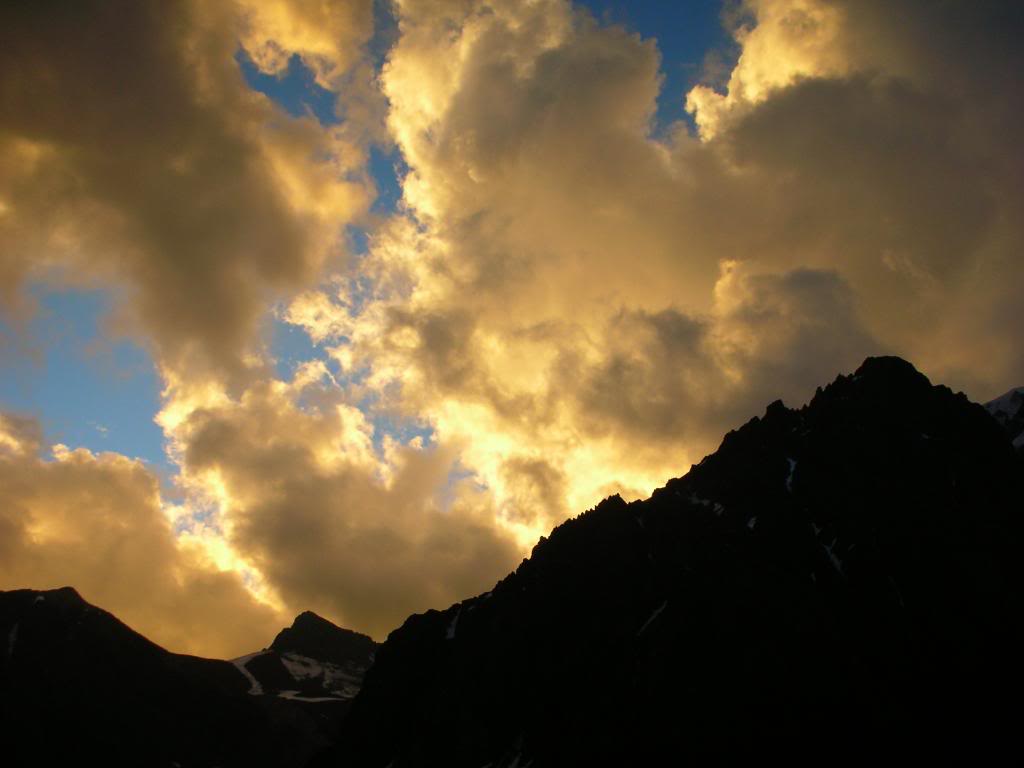
A beautiful sunset over Cerro Catedral, Jan 1, 2009.
The four from Sau Paulo, Brazil were named Bruno, Sandro, Tiago, and Roberto. I instantly made friends with them as they incorporated me into their expedition. I was extremely grateful towards them, I could not believe how accepting they were of such a complete stranger. Over the following days, the five of us rested at Mulas, carried to Camp Canada at 16,000‘, rested again at Mulas, then moved to Canada. We were at Camp Canada for two nights (Jan 2 and 3).
From Canada we carried and moved to Nido de Condores (17,700‘) on January 4 and 5. I was feeling as strong as ever and enjoying every second of being on the mountain. My mind began to forget the stress of losing Ryan and focus solely on the task at hand with my new friends.
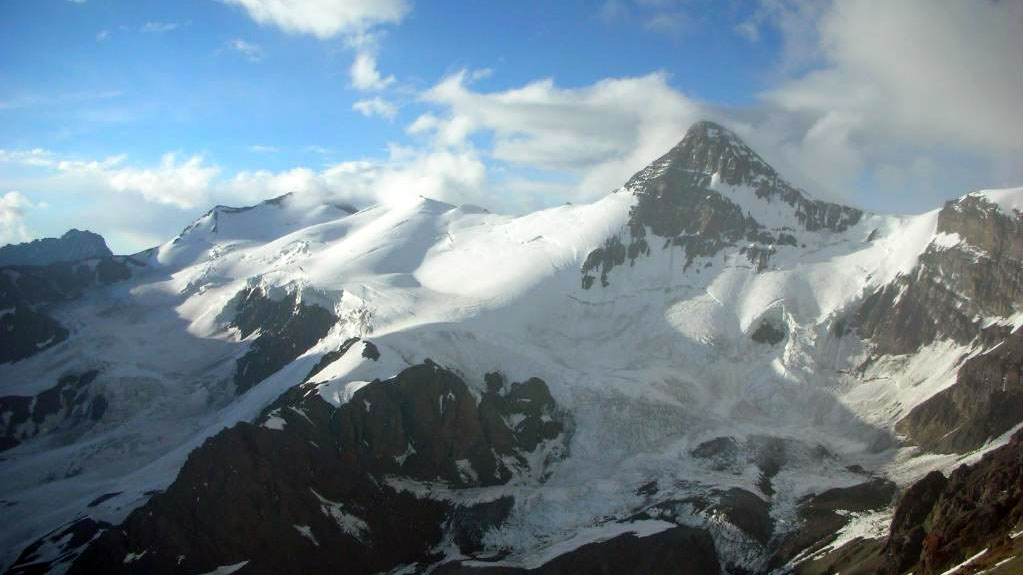
Cerro Cuerno (17,700‘) from Camp Canada, Jan 2.
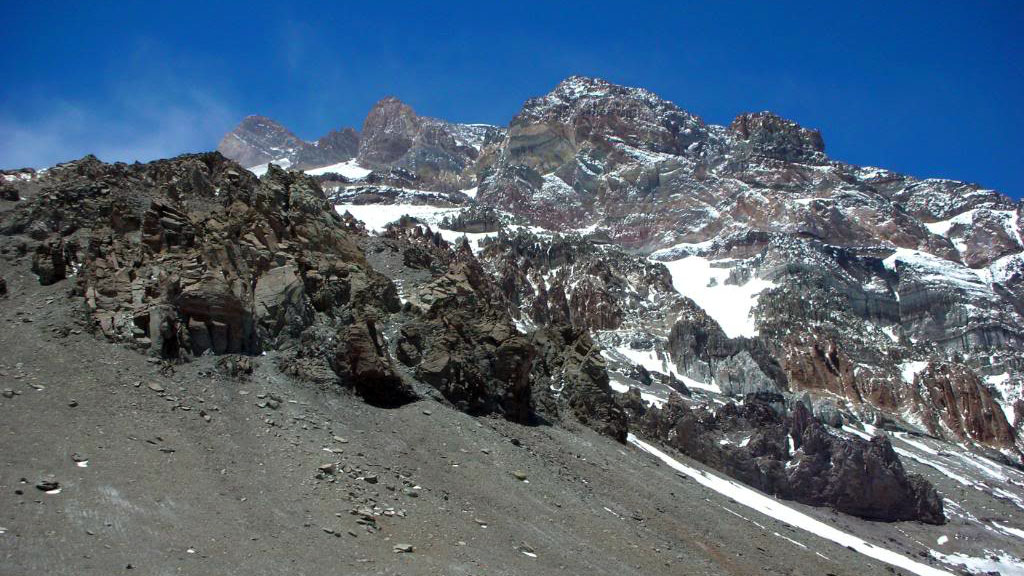
Looking up at the summit from Canada, Jan 2.
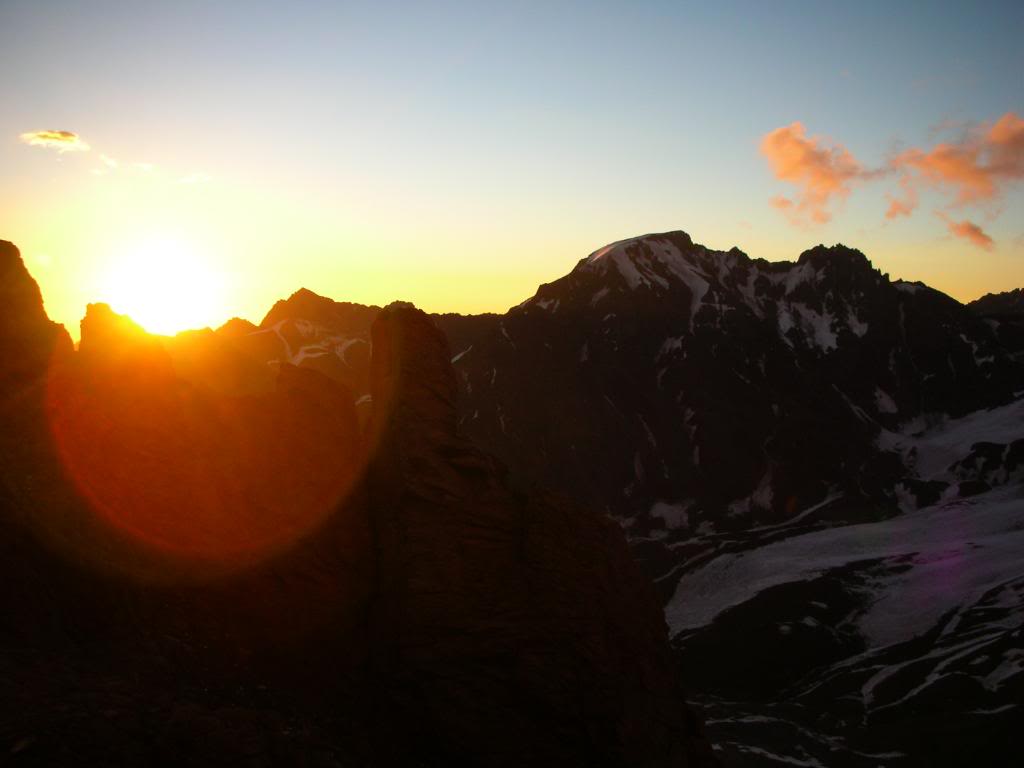
Sunset from Canada, Jan 3.
I shared a tent with Roberto, a thirty-one year old high-school physics teacher from Sau Paulo. We spoke broken Spanish and English to each other for days, I actually became very good friends with all four of them over the short amount of time I was with them, it really was an amazing experience to be so close with complete strangers. On January 6th, three of us moved to Camp Berlin at 19,400‘ and two descended to base camp after the altitude became a bit too much for comfort. Roberto, Tiago, and I were the remaining three.
We arrived at Berlin in the late afternoon after a heavy slog from Nido. Tiago was really feeling the altitude at this point and collapsed while Roberto and I set up the tent in an oncoming blizzard. Thirty minutes later when were were all safe inside our shelter, the blizzard turned into a real monster. Tiago and Roberto told me they were going to leave the following morning for Nido, it was at this point I realized I only had one real shot at making the summit, it had to be the next morning, and I would likely be alone.
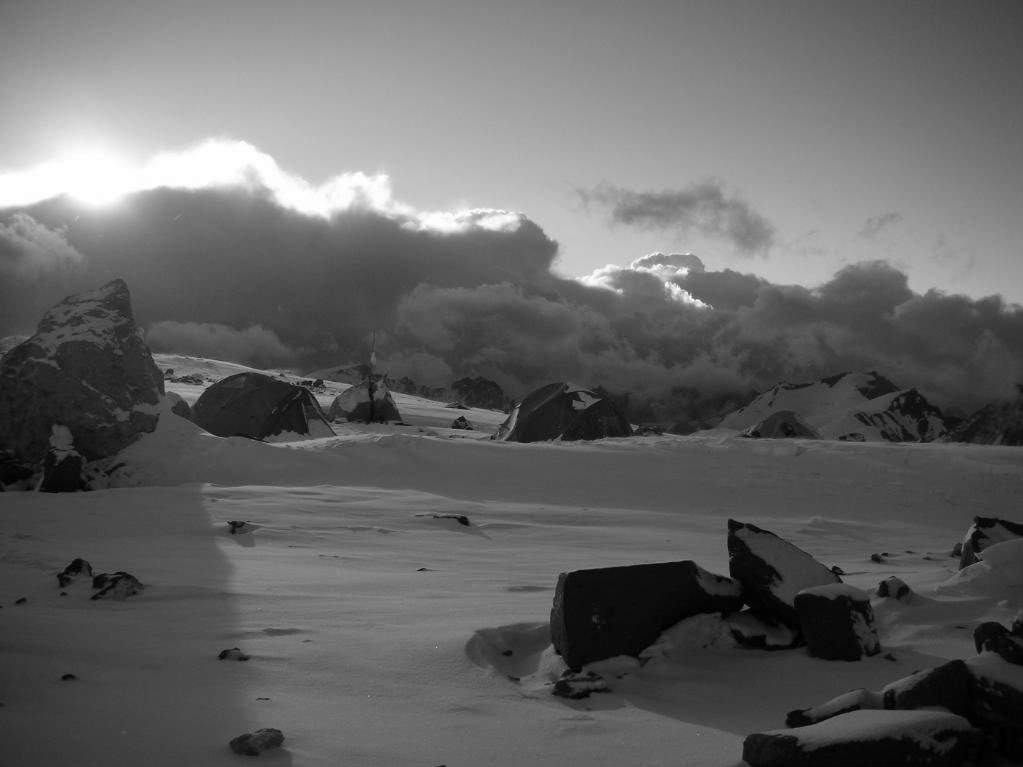
Nido de Condores after a storm, Jan 4.
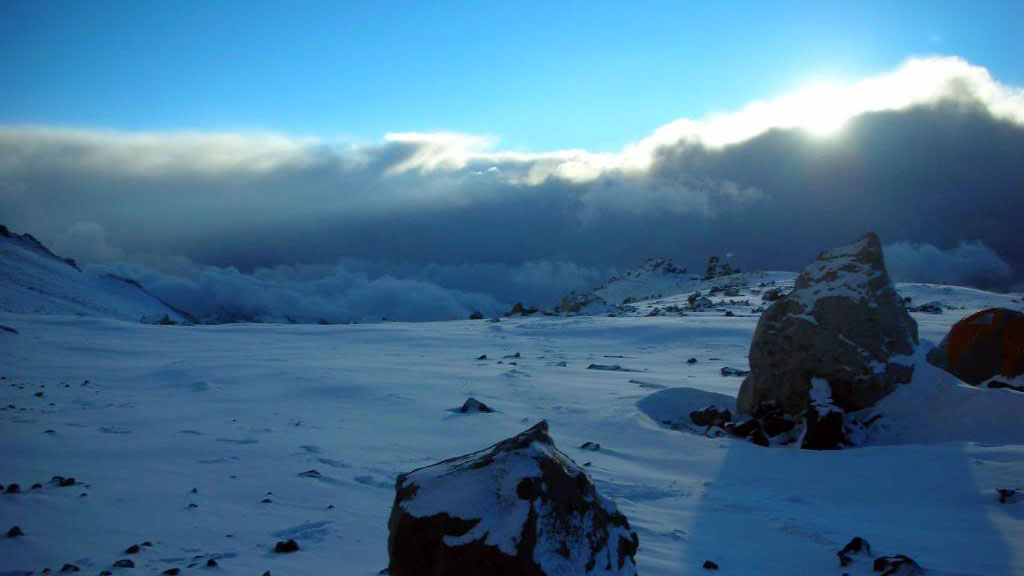
Looking to the southeast from Nido, Jan 4.
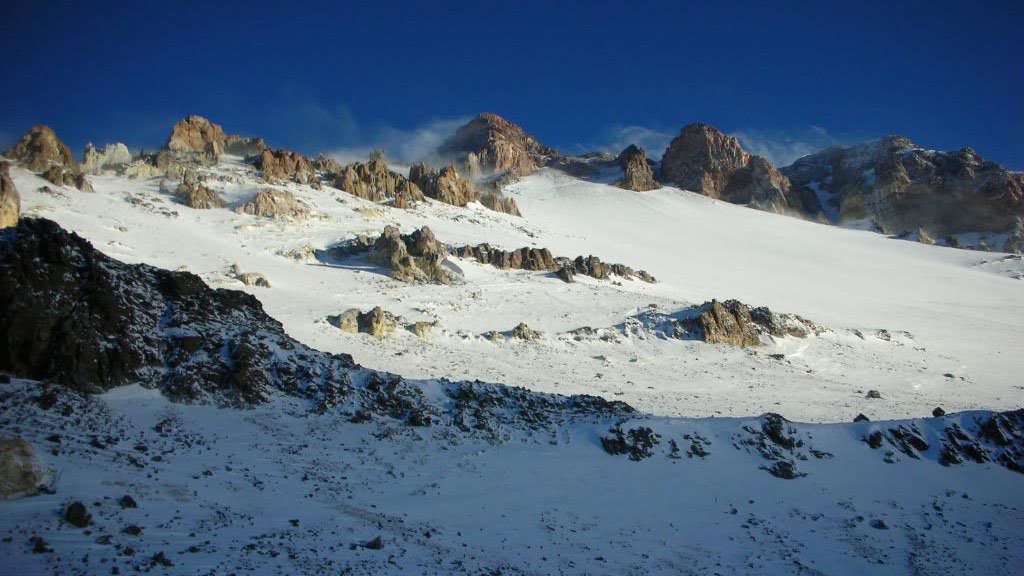
Looking up at the summit from Nido, the Gran Accero and “windy traverse” clearly visable.
We spent all night making nine liters of water for the three of us, the wind beat at our tent incessantly. I didn‘t get a wink of sleep throughout the night. In the morning we awoke to wind wind wind. Tiago and Roberto were cold and spent and decided they were heading down as soon as the sun hit the camp. This was difficult for me, I was extremely tempted to go for the summit on my own but I knew these impulses were most likely unhealthy. When the Brazilians began to pack up camp a few hours later, I was surprised to see two men in red jackets heading towards us. The men arrived at our camp and explained that there were four missing people, climbers from Italy and a guide, near the summit and that they were looking for any strong, able bodies to help look for them. I immediately volunteered as I was feeling both strong and warm, Tiago and Roberto continued with their plan to head down.
I put on my crampons, filled a bottle with two liters of water, and set off with the two search and rescuers. I was extremely excited at this point as I knew the summit was still a possibility (although it was very cold), and I knew I may be able to help some climbers in need as well, in truth I didn‘t really know what to expect. As we climbed an alternate route from Berlin, one of the rescuers soon fell behind. By the time Carlos, the remaining rescuer (the same guy who had helped Ryan ten days earlier), and I reached 20,000‘, we were completely alone. The weather was acceptable although not perfect, and Carlos and I made good time to Independencia despite strong winds.
When we reached the broken down hut at noon, Carlos received a call on his radio instructing him not to continue until backup arrived. He told me that he was going to wait for two hours in the hut, and that I could either head down or wait with him. My hopes faded as I realized the amount of time I had to get to the summit was rapidly diminishing, and that I had no tent waiting for me at Berlin, it was now or never. As soon as I had this thought it was as if Carlos had read my mind, “usted no puede ir al cumbre hoy porque hay mucho viento.” (essentially he told me not to go to the summit because of the wind). I evaluated my abilities against the 1,500 remaining vertical (my altimeter read 21,300‘) and decided that it would be foolish to go by myself, especially considering that the largest rescue effort in Aconcagua‘s history was now underway.
I decided to respectfully back off the mountain. Two hours later, when I returned to Berlin for my gear, a storm enveloped the upper-mountain and killed two of the four missing Italians. Needless to say I was content with my decision to turn back.
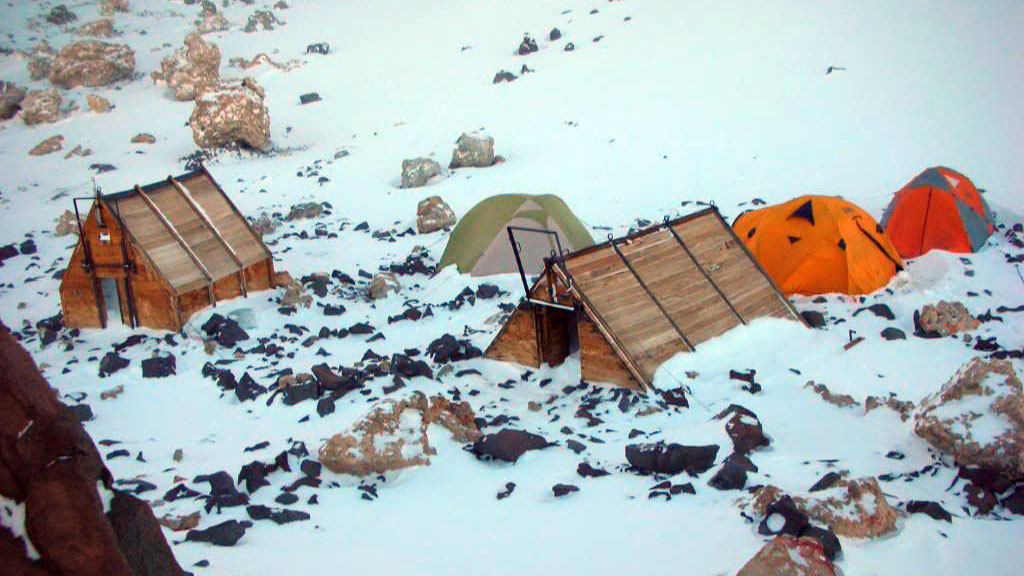
Camp Berlin (19,400‘), Jan 6.
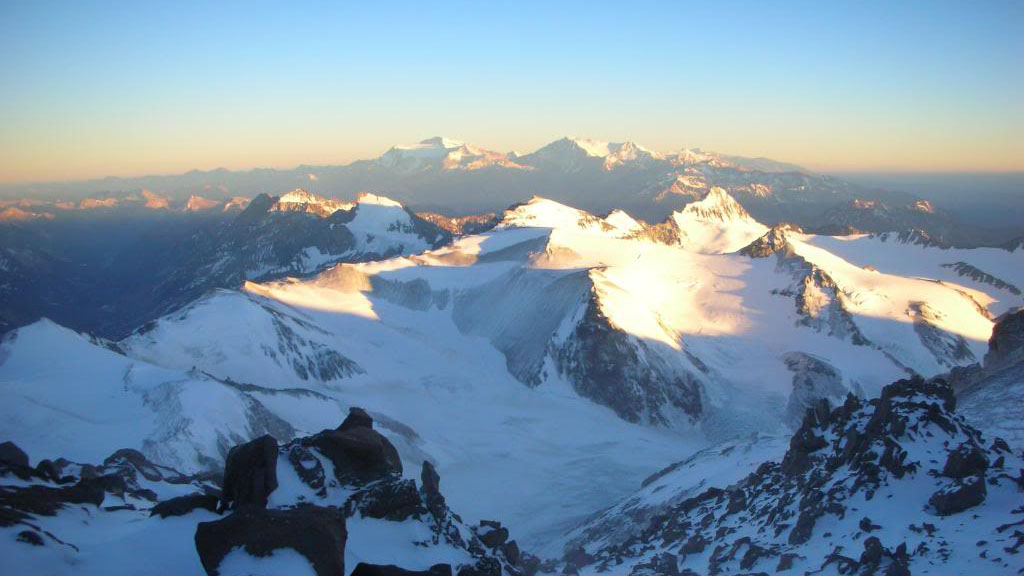
View from just below Camp Colera, Jan 7.
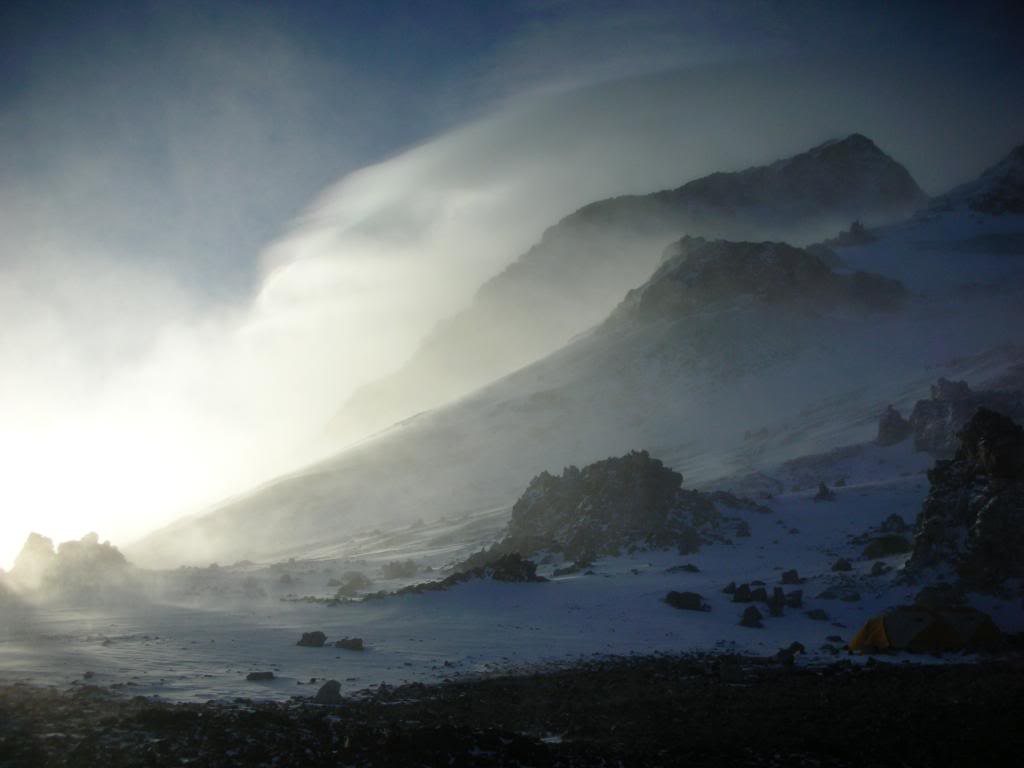
Looking at the summit from Colera, no one‘s summiting in that, Jan 7.
I returned to Mulas several hours later and rejoined my Brazilian friends. I was very disappointed that I failed to summit, but recognized that I made the only sensible choice at the time. This was made harder by the fact that it was never a question of strength or motivation for me, it was simply bad luck that deprived me of the top of the Americas. I have read many reports of people summiting on fine summer days, people with much less mountaineering experience than I. This wasn‘t supposed to happen to me, I had it all planned and calculated! I remember saying to someone a while back that ultimately the mountain will decide which climbers will summit and which will not. I guess I got to verify my own statement. At the rate I was climbing, I was confident that I could have made it from Independencia to the top in two and a half hours or less, it just wasn‘t in the cards for me this time, that is the plain reality of it that I have to live with, and damn its frustrating sometimes.
I refueled on tea and a steak dinner at base camp and slept great that night. The next day I headed down to the park entrance with the Brazilians, remembering SarahT‘s report of how much it would suck to descend this stretch having not summited (she was correct in her assessment). We arrived in the late afternoon and returned to Penetentes early enough to catch a bus to Mendoza. I decided to head to a hostel with the Brazilians to have a shower, shortly after we were eating a hamburger and drinking a coke in a Mendozan restaurant. I needed only to reunite with Ryan at this point and the whole trip would be pretty much in the bag, for the moment all was well.
I had told Ryan when we parted to check his email and that I would contact him the day before I would arrive at Penetentes (I sent him an email from the hotel in Mulas the day before). Long story short he received the email late and was planning to head to Penetentes via bus at 6am the morning after I arrived in Mendoza (another mis-communication which would land us in opposite towns at opposite times). As it turned out, the only way for me to stop him from traveling to Penetentes was to head him off at the bus station in Mendoza at 6am before he got on the bus. I stayed up all night and walked from the hotel “Sosa Haus” in central Mendoza to the bus station at 5:30am.
After waiting for fifteen minutes I was elated to see the familiar figure of a short, beardless American heading towards platform forty-five where I was waiting. Ryan was as surprised to see me as I was him. He had been living the life; wine, girls, hostels, tours, friends from different countries, etc etc. I was a little jealous actually. We were walking back to Sosa Haus sharing our stories, happy to be reunited again for the first time in eleven days, I was very excited to see Ryan.
When we arrived at the corner of San Luis and San Martin in central Mendoza, I began sharing my experience on the mountain with him. The time was 6:15am. While we were walking, I first noticed an arm around my shoulder. “Hola mi amigo, como estas?”, said a voice. I looked and found that the arm belonged to a shirtless man in his late twenties. He had come out of nowhere, along with two others behind him. I felt uncomfortable, I brushed his arm off my my shoulder. Ryan was bothered by the whole proceeding and intentionally put some distance between himself and the men. I remember thinking they were just guys who wanted to screw with us because we were American, I didn‘t want to believe they meant us harm.
I put some distance between myself and the men, and watched as, to my horror, the shirtless man picked up a large piece of concrete and began jogging towards me. I remember thinking that I didn‘t want to turn my back on him because I wanted to know where the concrete was coming from. Backpedaling, I watched him cock his arm and throw the concrete, I followed its path and side stepped it, the block broke apart against the wall behind me. I didn‘t know where Ryan was at this point, but I could hear him to my left telling me to run. I began to jog away from the attackers and was surprised to see one of them circling around in front of me, presumably to head me off. I made a quick choice to run at him and throw an elbow into his face. I didn‘t see what happened but Ryan later told me he went “flying on his ass”. At this point I was optimistic as I looked and saw Ryan right behind me as well as a clear passage in front of me. “Run!”, Ryan said again, I began sprinting down the street with Ryan at my heels.
About a hundred yards later I turned and looked over my shoulder, the men were not chasing us. A feeling of relief came over me, we were free! I looked over at Ryan and saw the blood; he had a large, twelve inch diameter blood stain on his shirt, he was stumbling down the street. “I think I got stabbed”, he said. For the second time on this trip my mind raced life and death thoughts; “Oh God, how bad is it? I‘m about to watch my best friend die. What the hell just happened??” I remember being angry above all else.
I ran through the streets to the west of our location and quickly found a taxi out on morning duty. I directed the taxi to Ryan‘s location and found that he was already heading towards us, I ran around and opened the door for him. When we were both inside the driver understood and proceeded to blow through several red lights to get to the “Hospital Central”. I remember putting pressure on Ryan‘s chest with my hand and telling him to hold on. We arrived at the emergency room in less than five minutes and Ryan was taken into the back, I was not allowed to follow.
During the ensuing hours I was told Ryan‘s wound was superficial and he would be released as soon as more tests were performed, then four hours later when I was filling out a police report at the station in central Mendoza, I was told there was a complication and Ryan required immediate surgery. The situation coupled with the fact that I had hardly slept since climbing to 21,000‘ proved to be too much for me. For the first time on the trip I started to break down a bit. I remember feeling extremely helpless, like I had no control whatsoever over the situation, I didn‘t even know how to get back to the hospital. I couldn‘t call Ryan‘s loved ones, I couldn‘t contact my wife, I couldn‘t depend on anyone for help. It was just me and Ryan and his life was in the hands of third-world doctors. It was the lowest point of the trip for me.
Ryan came out of surgery an hour later as I arrived at the hospital and the doctors told me he was most likely going to be okay. Turns out he did not have pain-killers for an hour after undergoing liver surgery for internal bleeding. When I arrived in his operating room he was in intense pain but otherwise alright, it looked like we were gonna make it through. I contacted my wife who kindly contacted our friends and family and began a prayer chain, I also posted here on 14ers.com. The support we received was unbelievable, thanks you guys.
Ryan and I read several books over the next four days including “Into Thin Air” and “Touching the Void”, Ryan made a great recovery and we were able to leave only three days later than planned. We also had a few days out of the hospital in which Ryan couldn‘t fly safely, we were able to get out and eat, explore Mendoza, and drink copious amounts of wine (no carbonation the doctor said or it would have been beer). Getting back into the U.S. was yet another surreal experience for me, I could not believe we had been gone for almost a month. Ryan went to see a liver specialist a few days later who told him he should make a full recovery soon, I think a winter ascent of Mt. Princeton is in short order :D.
I‘m not sure if a return to Aconcagua is in the cards for me. There are so many mountains I would love to attempt in my lifetime, many of which are much more aesthetically pleasing than Acon. I do believe I have gained an extensive amount of knowledge on how to iron out the wrinkles on a future Acon trip however, and I have not fully decided against returning. Ryan is fervent about returning for another go in the next two years. My time on Aconcagua was amazing, I am extremely grateful to have met the Brazilians as well as the park rangers and doctors I became such good friends with. I learned much about the art of high-altitude mountaineering, and much about the planning and logistics behind big mountain expeditions. The experiences on this trip were priceless. On top of that I did stand at an elevation higher than Kilimonjaro, the Ecuadorian Volcanoes, and Denali, and I did it all without even a minor headache at any point. I feel I have plenty to be proud of and plenty of successes to warrant future trips to high places.
In the airport in Santiago, Ryan and I had coffee with an Aconcagua guide who turned out to be none other than Marty Schmidt, two time K2 summiter and veteran Himalayan mega-climber/guide. He sat and kindly encouraged us to return, ensuring Ryan that he simply needs to continue his penance on lesser peaks and return stronger in the future, and ensuring me that I was right in turning back, that sometimes it takes more strength to turn around than it does to go to the summit. Marty has turned back on many peaks in his life, he asserted that the summit is not nearly as important as the lessons learned while on the mountain. After this climb I would have to agree.
I personally am happy with my choice to turn back given that four died during my eleven days on the mountain. I do however remain disappointed that I was unable to rest in a tent at Berlin and try again the following day, the situation just didn‘t lend itself to this contingency on this particular trip. Overall this trip was the next level for me, I will never forget the experience and I believe I have gained valuable knowledge on how to handle future climbs and life situations. Cheers and thanks for reading.
The Brazilians and I ended up in an Argentinian newspaper (third picture down):
http://www.mdzol.com/mdz/nota/98995-Protagonistas-del-Aconcagua-2009/
. . . and here is the story for Spanish speakers:
http://www.mdzol.com/mdz/nota/98327-Aconcagua-09–Nota-6-La-otra-historia-(los-que-salvan-su-vida)/
A few more pics:
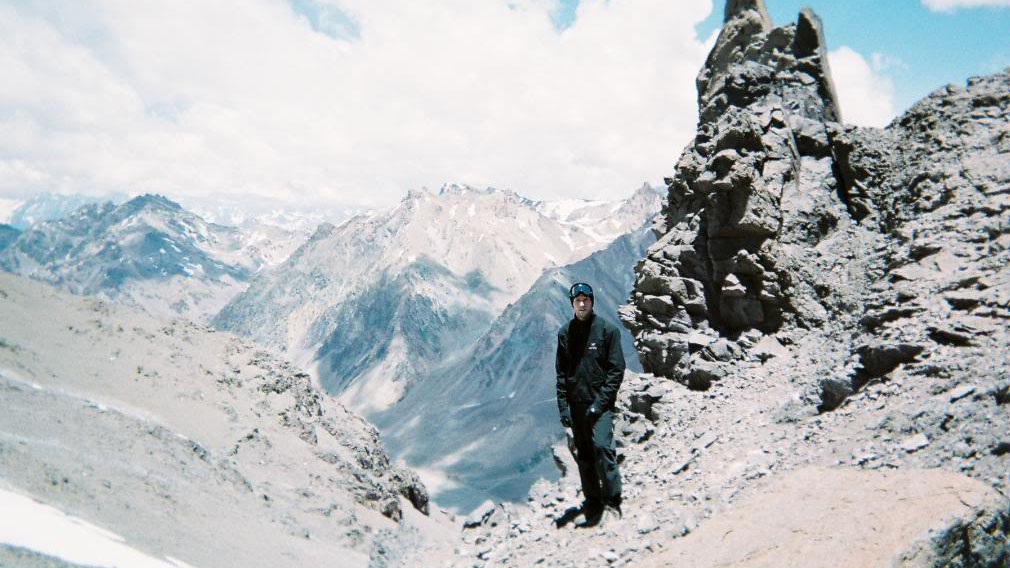
Self portrait at Camp Canada.
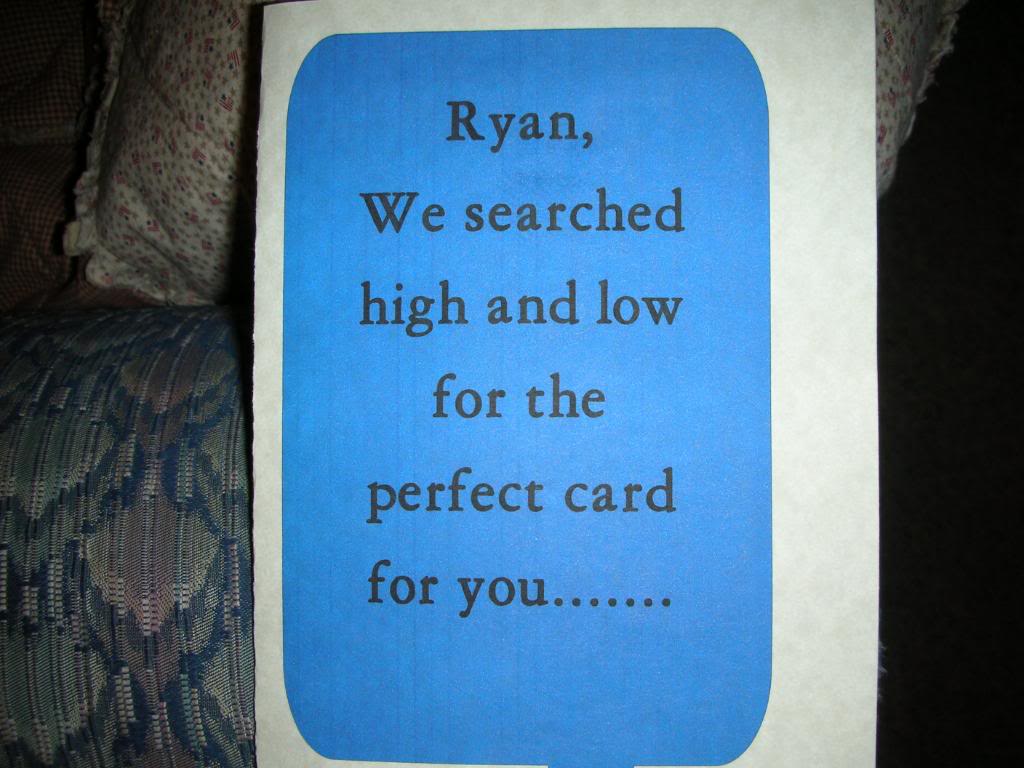
Ryan’s welcome home card.
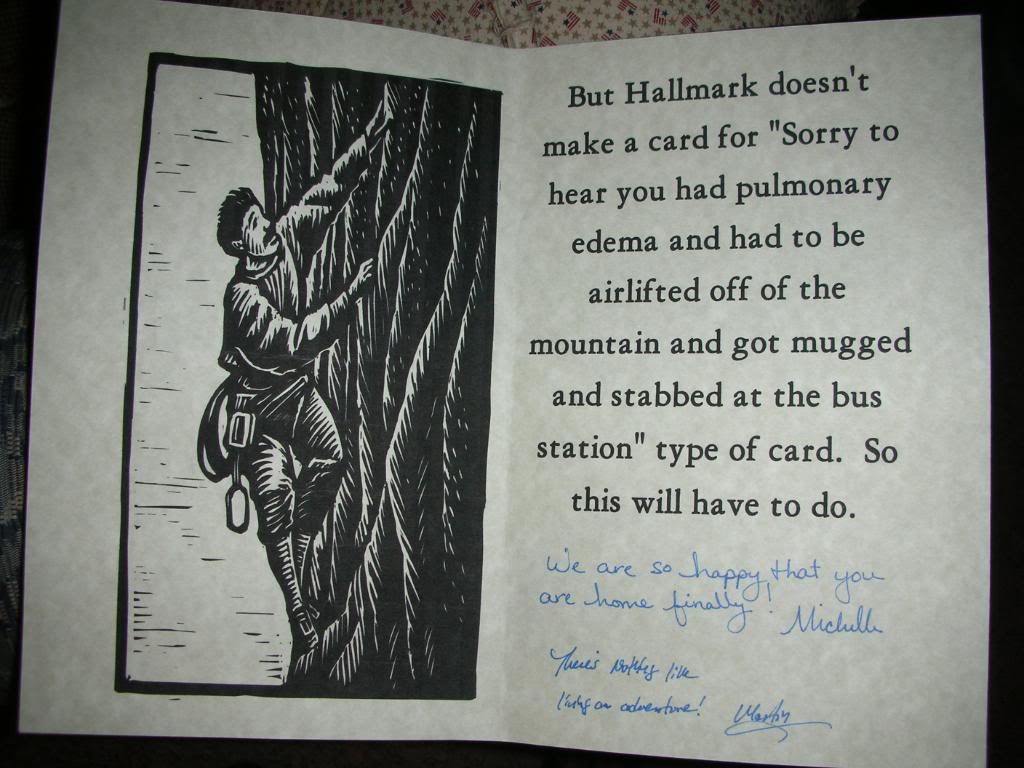
Part 2.
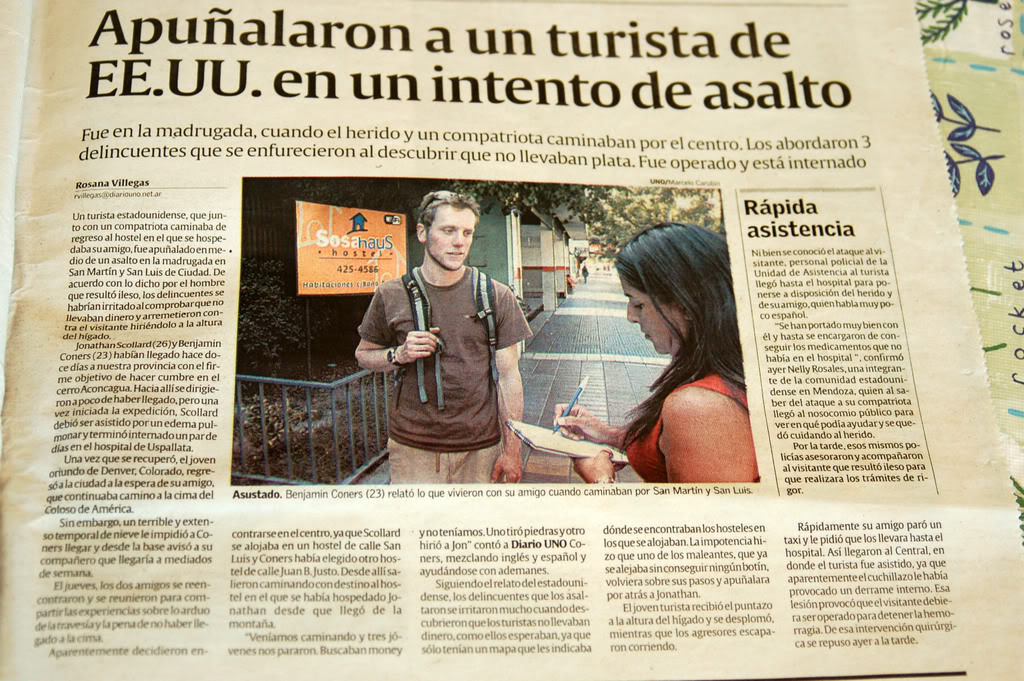
The media found me several times after the incident, my name has two n‘s!
Cheers!
